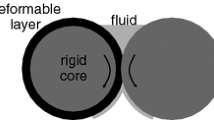Abstract
After thermoforming, plastic parts are stacked for ship**, and these parts tend to stick together. Called nesting, sheet stock is often first coated with a silicone compound before thermoforming to prevent this. The coating usually consists of a small amount of lubricant dispersed in a majority of carrier fluid, and this fluid must then dry before reaching the sheet winder or else the coating blotches. This coupling of coating and drying to determine when to expect blotching is examined. Roll coating involves a dimensionless group called the elasticity number that governs the thickness of the coating to be dried. The drying section involves the evaporation of the coating carrier fluid, and then diffusion into the dry surrounding atmosphere. When analyzing the drying, a new dimensionless group that governs blotching is discovered, called blotchability. The result of this analysis allows practitioners to determine which operating conditions cause blotching, and how to eliminate it. Roll coating uses a deflecting rubber roll to apply vanishingly thin coatings (≤1 μm), an interesting elastohydrodynamic problem.








Similar content being viewed by others
Notes
Coating theory requires Young’s modulus; however, practitioners use a durometer to measure the rubber cover hardness. Deducing Young’s modulus from the measured hardness with a durometer following Gent6 is recommended. Mix and Giacomin7 have also developed a conversion from durometer hardness to Young’s modulus.
References
Coyle, DJ, “Forward Roll Coating with Deformable Rolls: A Simple One-Dimensional Elastohydrodynamic Model.” Chem. Eng. Sci., 43 2673–2684 (1988)
Coyle, DJ, Macosko, CW, Scriven, LE, “Film-Splitting Flows in Forward Roll Coating.” J. Fluid Mech., 171 183–207 (1986)
Middleman, S, Fundamentals of Polymer Processing, Chapter 8. McGraw-Hill Book Co., New York (1977)
Cohu, O, Magnin, A, “Forward Roll Coating of Newtonian Fluids with Deformable Rolls: An Experimental Investigation.” Chem. Eng. Sci., 52 1339–1347 (1997)
Smith, JW, Maloney, JD, “Flow of Fluids between Rotating Rollers.” Tappi J., 49 63 (1966)
Gent, AN, “On the Relation Between Indentation Hardness and Young’s Modulus.” Trans. Inst. Rubber Ind., 34 46–57 (1958)
Mix, AW, Giacomin, AJ, “Dimensionless Durometry.” Rheology Research Center Report, 182, 2008.
Carvalho, MS, “Effect of Thickness and Viscoelastic Properties of Roll Cover on Deformable Roll Coating Flows.” Chem. Eng. Sci., 58 4323–4333 (2003)
Bird, RB, Stewart, WE, Lightfoot, EN, Transport Phenomena, pp. 613–616. Wiley, New York (2007)
Acknowledgments
We thank Plastic Ingenuity, Inc., of Cross Plains, Wisconsin, and the Bemis Company, Inc., of Neenah, Wisconsin, for their financial support, through their memberships in the Industrial Consortium of the Polymer Engineering Center at the University of Wisconsin. We are also indebted to the Placon Corporation for its sustaining sponsorship of the Rheology Research Center at the University of Wisconsin. We are further grateful to Professor R. Byron Bird of the University of Wisconsin for his careful corrections.
Author information
Authors and Affiliations
Corresponding authors
Appendix: carrier fluid volatility
Appendix: carrier fluid volatility
When a volatile coating dries, it liberates carrier fluid mass, in the form of a gas at the drying surface. This gas moves away from its liberating coating surface, and thus slightly accelerates drying. The drying analysis presented here
conservatively neglects this, which yields9
where φ is given implicitly by
and where
the molecular weights M w and M A are defined in Table 1. When water is the carrier fluid, θ f from (27) hardly exceeds θ f from (33) because x s ≅ 0 and then (33) reduces to (25). For more volatile carrier fluids, equation (25) can significantly overpredict θ f.
Rights and permissions
About this article
Cite this article
Mix, A.W., Chen, Z.B., Johnson, L.M. et al. Blotching in roll coating. J Coat Technol Res 8, 67–74 (2011). https://doi.org/10.1007/s11998-010-9282-1
Published:
Issue Date:
DOI: https://doi.org/10.1007/s11998-010-9282-1




